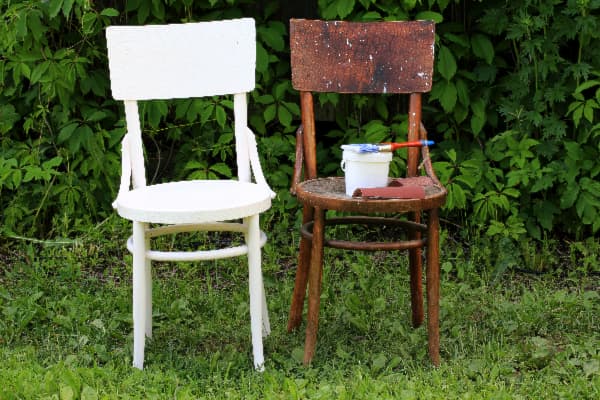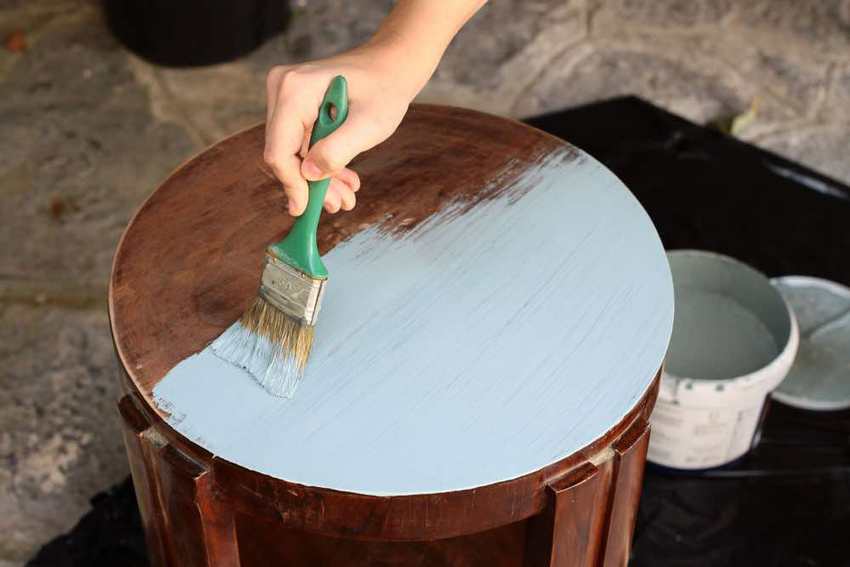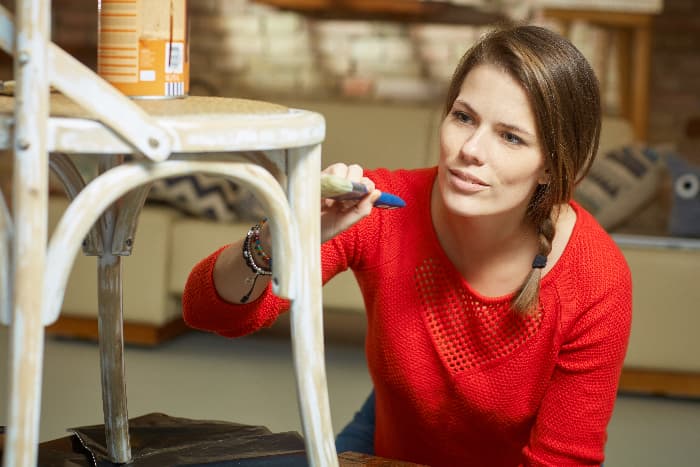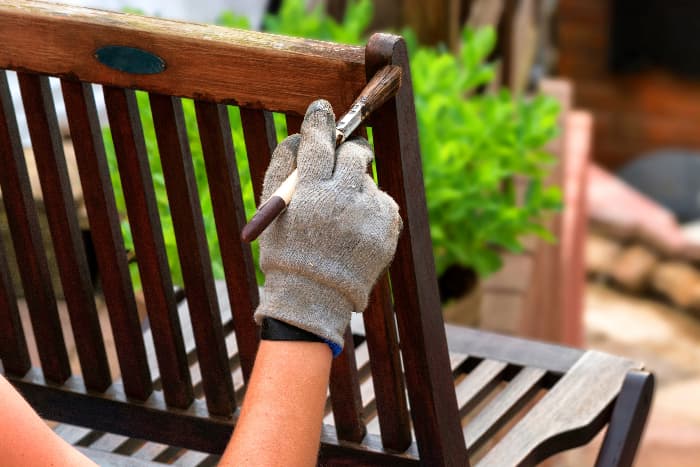Do You Use Primer Over a Stain Before U Stain Again
Painting is one of the fastest means to spruce up furniture, cabinets, and other projects around the abode, but to paint over stain tin be a tricky process. Even though we're leaving behind the deep woods grains and natural colors of the stain, we notwithstanding desire to have a not bad terminate to our dwelling decor.

At that place are a few steps involved in any paint over stain project. While you could just slap a coat of pain on, you'd exist risking a less than professional person finished project. Answering "Can you paint over stain?" covers some basic woodworking skills that tin turn you into a DIY good.
Y'all tin can paint over stain, but it takes a little work. The first step is getting the stained surface ready for painting past sanding and priming the woods. (If you're on a fourth dimension crunch, you can skip to the terminate of this piece for a shortcut on how to paint over stain in merely 2 steps!)
The Quick Reply
Here's the lightning fast guide for painting over stained wood.
The commencement thing is to figure out what kind of pigment you lot want to piece of work with and what type of stain you're painting over. Our guide goes over a few tips and tricks for this process. There's even a underground DIY paint that can skip all the sanding and priming if you want fast results.
Afterwards that, gear up the wood. You'll need to do some sanding, potentially use some solvents to remove the top coat, and and so prime the wood. One time this is done, yous tin paint and stop as you'd like.
Painting over stained woods is an piece of cake process when you really get downwards to information technology. Now, let'south become into detail nigh how to reply "Can you paint over stain?"
.
Painting Over H2o-Based Stains

Water-based stains are much easier to paint over than oil-based stains. These stains work by sinking into the wood which means that the forest grain is still exposed on top of the article of furniture. This ways that you exercise not typically need to use whatever solvents to become rid of them.
Here's how you can paint over stains that are water-based.
Cleaning Before You Work
Here's the commencement step.
Before the brushes, the sanding, and the painting, we demand to clean our furniture or other stained forest project.
Use warm soapy water to remove whatever dust, clay, and cobwebs before nosotros really get to work. Nothing ruins a paint job like accidentally painting over a cobweb or a grimy patch on the side of a new table.
Cleaning ensures y'all are working with the best slice of article of furniture you have to work with!
Information technology tin can be tempting to skip this stride, but take our discussion for it. Cleaning is the most important step of painting over stained wood.
One time your project dries, you're set to move onto step 2.
Sanding Downwards the Stain
You'll demand to sand the forest with a 150 dust sandpaper. This is how it'southward washed.
You'll want to sand with the grain to avoid unpleasant crosshatched patterns on your finished piece of furniture. This sanding isn't to become rid of the stain, just to requite the wood some "bite." This lets the pigment stick to the forest and gives you the all-time results when you start painting.
Some paints, which we go to later, permit yous skip this step. However, even with those paints yous can e'er benefit from a quick sanding.
Once that'south done, it's time to handle repairs.
Do Any Repairs At present
Noticed a scissure while you were cleaning? What about a stuck drawer while y'all were trying to sand?
At present is the all-time fourth dimension to tackle these projects. Why'southward that?
When you lot start painting the wood, you want to know that information technology's ready. If you have to do some repairs subsequently the fact, you run the risk of chipping or scratching your brand-new paint chore. Before painting is the platonic time to piece of work on any quick fixes or modifications you desire to make to your projection.
Employ Primer
Once the repairs are done, it's fourth dimension to add primer.
If yous've been doing DIY or painting for a while, you've probably heard everyone talking almost primers, but what do they do?
Primer coats non but get the wood ready for paint, they also help to protect information technology. These are also called undercoats as compared to the final "height" glaze that people encounter every day. Adding primer makes pigment stick improve while also helping you to have a more than durable finished projection.
One time all this is done, it's time to paint!
Have Fun Painting
When it comes time to paint, this piece of work is best done in multiple coats.
Yous'll want to make sure to always paint with the grain of the woods to give you the all-time concluding look for your project. This will also help y'all protect the forest when it comes time to remove the pigment down the road for a refresh or a new wait.
Think to let the pigment fully dry out in between coats. This helps you to avoid fisheyes or bubbling as the layers of pigment dry over each other. It as well prevents cracks in your finished paint job.
In one case all your coats are dry, you can add together a top coat to protect the finished paint job or leave it bare. It all depends on the level of traffic your final piece is going to exist exposed to.
If you're going to paint over an oil-based stain, the steps you'll have are mostly the same. There is, however, one big departure for paining over oil-based stains and that'southward using solvents to remove the stain.
Painting Over Oil-Based Stains

Alight, this is where things go a trivial bit more catchy.
Oil-based stains are much harder to remove than water-based stains. They stay on top of the wood and create a protective coating that helps the forest to stay water tight and scuff resistant. These stains as well create a bit of a problem when it comes to painting over them.
In order to paint over these stains, we're going to need to fully remove that top coat of oil-based stain.
Clean Your Project
The kickoff step is pretty much the same as with water-based stains.
You lot want to make certain that the piece of article of furniture you lot are going to paint is clean and set to go. Make sure to look for those piddling hard to attain places that can take built up grit from the ages.
Yous don't want to cease your projection and realize that you painted over a huge section of cobwebs!
Get Ready to Work With Solvents
When working with solvents, you can do this in your garage or a community workspace with some loftier-powered ventilation. In whatever example, you want to make sure that the windows are open and the fans are going.
These solvents create volatile fumes that can be harmful to pare, optics, and lungs. This is not the blazon of thing you want to endeavour to power through or tough out. Ideally, you'll accept a ventilator or mask on paw for when you're working with these solvents.
To apply the solvent, y'all're going to want to follow the manufacturers' directions on the packaging. This typically involves letting the solvent soak into the wood for a while before wiping information technology off and cleaning upward any remaining solvent and stain.
Here's a handy tip for working with solvents. Because they demand to soak into the woods for a while, and yous don't actually want these chemicals hanging effectually any longer than you lot need to, fix a timer. Either use your smartphone, microwave, or oven to fourth dimension however long these solvents need to piece of work for. This manner y'all won't lose rails of how long they've been working for.
The side by side step is to get the woods ready for pigment.
Prime and Paint
Once the solvent has done it's magic, yous've got as close to bare wood as you lot're going to get!
Utilize your primer and permit information technology piece of work into the woods and then start with your base glaze, acme coat, and end as desired.
Oil-based stains are much harder to remove and paint over than water-based stains, but it is totally possible to work with these stains. With the right equipment and a properly ventilated space, whatever piece of sometime furniture tin be repainted to meet a more than modernistic design sensibility.
How To Tell If You're Dealing With Oil or Water-based Stain
Wow! The procedure of handling oil and water-based stains is totally different. What if you've got a piece of vintage article of furniture, and you can't tell what it was stained with?
Here's an like shooting fish in a barrel test that you can do without whatsoever addition equipment. Just take a little fleck of water and sprinkle it onto the surface of your article of furniture. If the water beads up, information technology'due south an oil-based stain. If the h2o doesn't, and then it's water-based. Keep in listen that this isn't e'er 100% accurate and farther testing with solvents similar Goo Gone might be needed to become the virtually authentic results.
The Two-Footstep Shortcut to Pigment Over Stains

Are y'all ready for the ultimate shortcut respond to the question "Can you paint over stain?" Here it is: Chalk paint.
Chalk paint is a retro type of paint that was largely forgotten when petroleum-based paints took over the market. However, the recent motility away from petroleum products and a desire to explore vintage styles has brought chalk paint back into fashion.
These paints leave a matte terminate if no top coat is applied. They also accept a tactile touch that many people find pleasant. These paints slide into modern every bit well as farmhouse looks with ease.
The process here is much easier than with whatsoever of our other strategies. All you demand to exercise is apply one to ii coats of chalk pigment, and you're washed. Actually. It's that like shooting fish in a barrel!
Chalk paint can naturally adhere to pretty much any surface. You don't even demand to sand even though a quick sanding would help the paint to adhere properly. You can also experiment with either a pristine looking stop piece or wear it downward a piddling for that farmyard salvaged look.
To finish your piece, you can either employ a topcoat of furniture wax or shellac to complete the rustic withal refined mode.
And so, Can You Pigment Over Stain?
Yes! It's a groovy way to take that thrift shop detect and elevate information technology into something that speaks to our modernistic moment. Painting over a piece of stained furniture is a i of the best ways to change up your current furniture for something a little more stylish.
Just make sure to follow our guide for the all-time results!
randolphwifforge53.blogspot.com
Source: https://www.thatsweettealife.com/can-you-paint-over-stain/
0 Response to "Do You Use Primer Over a Stain Before U Stain Again"
Post a Comment